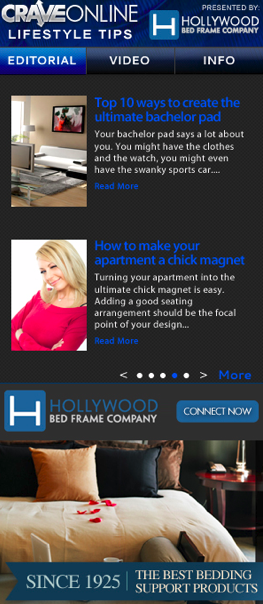
The digital media industry is struggling with how to provide unique ad experiences (ie not commoditized) while at the same time providing scale.
In a world of 4 trillion impressions, this isn’t a nice-to-have but a survival strategy. The big challenge, then, is not in ditching the banner ad but improving it. Evolve Media, a digital media company with 370 owned and operated sites, like SheKnows.com and CraveOnline.com, is conducting an interesting experiment with a hybrid of content-based ad programs and standardized units.
 Evolve’s approach is getting advertisers to sponsor a 300×250 unit that has both the brand’s logo and links to Evolve content. When someone clicks on an article within the unit, he is taken to the article which contains both an overlay and standard units with the brands ads. This unit ideally helps do away with the age-old problem of banner blindness. Inside the unit, a mixture of the site’s “most craved” content (the articles with the most clicks, comments, shares) as well as branded content. No brands are using the product yet.
Evolve’s approach is getting advertisers to sponsor a 300×250 unit that has both the brand’s logo and links to Evolve content. When someone clicks on an article within the unit, he is taken to the article which contains both an overlay and standard units with the brands ads. This unit ideally helps do away with the age-old problem of banner blindness. Inside the unit, a mixture of the site’s “most craved” content (the articles with the most clicks, comments, shares) as well as branded content. No brands are using the product yet.
“The advertiser is being consumed into that experience, and because it’s unique and native is running on the site, it has its own feel,” said Evolve president Brian Fitzgerald. “It makes it that experience for the brand; that they’re being enveloped by a native experience that’s unique to that site.”
The company realized that it needed a content-driven product because its users came to its sites because “they love the content the site produces; the look, feel, voice, the entire embodiment of the message,” Fitzgerald said. “Let’s work with each of our sites in a way to be able to ad serve but not serve a traditional ad. It’s figuring out how do you align content and commerce in a way that’s native to the site and audience you’re trying to market and communicate through,” he said.
Image via Shutterstock
More in Media

From sidelines to spotlight: Esports events are putting creators center stage
Esports events’ embrace of content creators reflects advertisers’ changing priorities across both gaming and the wider culture. In the past, marketers viewed esports as one of the best ways to reach gamers. In 2025, brands are instead prioritizing creators in their outreach to audiences across demographics and interest areas, including gaming.

Condé Nast and Hearst strike Amazon AI licensing deals for Rufus
Condé Nast and Hearst have joined the New York Times in signing a licensing deal with Amazon for its AI-powered shopping assistant Rufus.

Media Briefing: AI payouts may be entering a new era
AI compensation is evolving — and new models, not just publisher demands, are driving the shift beyond flat-fee licensing.





